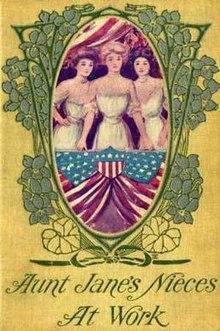What are you looking for at Aqrani library?
-

The Land of the Blue Flow...
The Land of the Blue Flower was not called by that name until the tall, strong, beautiful King Amor came down from his castle on the mountain crag and began to reign. Before that time it was called King Mordreth's Land, and as the first King Mor-dreth had been a fierce and cruel king this seemed a gloomy name...
-

The White People
This scarce antiquarian book is a facsimile reprint of the original. Due to its age, it may contain imperfections such as marks, notations, marginalia and flawed pages. Because we believe this work is culturally important, we have made it available as part of our commitment for protecting, preserving, and promoting the world's literature in affordable, high quality, modern editions that are true to the original work.
-

A Fair Barbarian
Miss Belinda Bassett's niece arrives in a small England town. Octavia Bassett arrives from Nevada with her trunks of fancy clothes, diamond jewelry, and gold coins for the poor. She soon becomes friends with Lucia Gaston, the repressed granddaughter of the village matriarch, Lady Theobald.
-

A Voyage in a Balloon
Jules Gabriel Verne (1828-1905) was a French author who pioneered the science-fiction genre. He is best known for novels such as Journey to the Centre of the Earth (1864), Twenty Thousand Leagues Under the Sea (1870), and Around the World in Eighty Days (1873). Verne wrote about space, air and underwater travel before air travel and practical submarines were invented, and before practical means of space travel had been devised. He is the third most translated author in the world, according to Index Translationum. Some of his books have been made into films. Verne, along with Hugo Gernsback and H. G. Wells, is often popularly referred to as the "Father of Science Fiction." Amongst his other works are From the Earth to the Moon (1867), Five Weeks in a Balloon (1869), The Fur Country; or, Seventy Degrees North Latitude (1873), The Blockade Runners (1874), The Field of Ice (1875), The Mysterious Island (1875), Facing the Flag (1879), and An Antarctic Mystery (1899).
-

Across The Plains
LEAVES FROM THE NOTEBOOK OF AN EMIGRANT BETWEEN NEW YORK AND SAN FRANCISCO MONDAY. - It was, if I remember rightly, five o'clock when we were all signalled to be present at the Ferry Depot of the railroad. An emigrant ship had arrived at New York on the Saturday night, another on the Sunday morning, our own on Sunday afternoon, a fourth early on Monday; and as there is no emigrant train on Sunday a great part of the passengers from these four ships was concentrated on the train by which I was to travel. There was a babel of bewildered men, women, and children. The wretched little booking-office, and the baggage-room, which was not much larger, were crowded thick with emigrants, and were heavy and rank with the atmosphere of dripping clothes. Open carts full of bedding stood by the half-hour in the rain. The officials loaded each other with recriminations. A bearded, mildewed little man, whom I take to have been an emigrant agent, was all over the place, his mouth full of brimstone, blustering and interfering. It was plain that the whole system, if system there was, had utterly broken down under the strain of so many passengers.
-

All Around The Moon
Over this chaotic region the travellers were now sweeping, as if borne on the wings of a storm; the peaks defiled beneath them; the yawning chasms revealed their ruin-strewn floors; the fissured cracks untwisted themselves; the ramparts showed all their sides; the mysterious holes presented their impenetrable depths; the clustered mountain summits and rings rapidly decomposed themselves: but in a moment again all had become more inextricably entangled than ever. Everything appeared to be the finished handiwork of volcanic agency, in the utmost purity and highest perfection. None of the mollifying effects of air or water could here be noticed. No smooth-capped mountains, no gently winding river channels, no vast prairie-lands of deposited sediment, no traces of vegetation, no signs of agriculture, no vestiges of a great city. Nothing but vast beds of glistering lava, now rough like immense piles of scoriae and clinker, now smooth like crystal mirrors, and reflecting the Sun's rays with the same intolerable glare. Not the faintest speck of life. A world absolutely and completely dead, fixed, still, motionless—save when a gigantic land-slide, breaking off the vertical wall of a crater, plunged down into the soundless depths, with all the fury too of a crashing avalanche, with all the speed of a Niagara, but, in the total absence of atmosphere, noiseless as a feather, as a snow flake, as a grain of impalpable dust.
-

An Inland Voyage
As a young man, Stevenson wished to be financially independent and began his literary career by writing travelogues. This is his first published work, written at a time when travel for pleasure was still a rarity. He and a friend traveled by canoe through France and Belgium and he relates how they were thrown in jail, mistaken for traveling salesmen and became embroiled in gypsy life.
-

Aunt Jane's Nieces and un...
Aunt Jane's Nieces and Uncle John picks up the continuing story of the three cousins Patsy Doyle, Beth De Graf, and Louise Merrick, and their family; the plot of the book begins three days after the wedding of Louise and her fiancé Arthur Weldon, the event that concluded the sixth book in the series, Aunt Jane's Nieces in Society. Uncle John hires a touring car and the party makes a tour of the South West, visiting New Mexico and Arizona.
-

Aunt Jane's Nieces at mil...
Aunt Jane's Nieces at Millville is a 1908 young-adult novel written by L. Frank Baum, famous as the creator of the Land of Oz. It is the third volume in "the successful Aunt Jane Series," following Aunt Jane's Nieces and Aunt Jane's Nieces Abroad. Aunt Jane's Nieces at Millville picks up the story of the three cousins, Patsy Doyle, Beth De Graf, and Louise Merrick, soon after their return from Europe in Aunt Jane's Nieces Abroad. As in that earlier book, their benign and eccentric millionaire Uncle John devotes much of his fortune to helping others — an effort managed by Patsy's father, Major Doyle. These efforts do not always yield fiscally sound results...
-

Aunt Jane's Nieces at wor...
The novel carries forward the continuing story of the three cousins Louise Merrick, Beth De Graf, and Patsy Doyle, and their circle. The title is somewhat misleading; it could more accurately have been called Aunt Jane's Nieces in Politics. (Uncle John Merrick tells his nieces that politics is "work," which yields the title.) The story begins three days after the end of the previous book, Aunt Jane's Nieces at Millville; the freckled and red-haired Patsy still sports a sunburn from her summer in the Adirondacks. She and Louise have received letters from their "cousin" Kenneth Forbes, the young man who inherited Aunt Jane's estate in the first book of the series. Kenneth has become involved in politics: he is running as the Republican candidate for the local seat in the New York State legislature, but thinks he is going to lose to his opponent. The family decide to go all out to help Kenneth win the election...